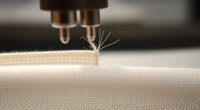Circular fashion helps you close the loop on textile waste by transforming old garments and fabric scraps into new, durable fabrics through innovative recycling. It encourages sustainable design principles like timeless styles, repairability, and eco-friendly materials, so garments last longer and reduce waste. By supporting brands that prioritize recycling and making eco-conscious choices yourself, you contribute to a healthier planet. Keep exploring how these practices reshape the future of fashion and waste reduction.
Key Takeaways
- Circular fashion emphasizes recycling, reusing, and regenerating textiles to minimize waste and extend garment lifecycles.
- Innovations like molecular-level fabric recycling enable turning old textiles into durable, new fibers, reducing reliance on virgin materials.
- Designing for longevity, recyclability, and modularity supports a closed-loop system, decreasing environmental impact.
- Consumer participation in responsible care and purchasing choices is vital for closing the fashion loop.
- Industry shifts toward sustainable materials and waste reduction techniques foster a circular economy in fashion.

Have you ever wondered how fashion can be more sustainable? The fashion industry has long been associated with waste and environmental impact, but recent innovations are changing that narrative. One of the most promising developments is the focus on recycling innovations. These advancements enable brands to transform old garments and textile waste into new, high-quality fabrics, reducing the need for virgin materials. Instead of discarding worn-out clothes or textile scraps, companies now utilize cutting-edge recycling techniques that break down fabrics at a molecular level, creating fibers that are just as durable and stylish as newly produced ones. This shift not only minimizes waste but also curbs pollution, as fewer textiles end up in landfills or pollute waterways.
Recycling innovations turn textile waste into durable, stylish fabrics, reducing landfill and pollution.
Alongside recycling innovations, sustainable design plays a essential role in closing the loop on fabric waste. It’s about designing garments with their entire lifecycle in mind, emphasizing durability, timeless style, and ease of recycling at the end of their use. When you choose clothing made with sustainable design principles, you’re supporting products crafted to last longer, reducing the frequency of replacements. Brands are increasingly incorporating eco-friendly materials, such as organic cotton or recycled polyester, and optimizing patterns to minimize fabric waste during production. These strategies help guarantee that every piece is manufactured with a purpose—to be worn for years, and then repurposed or recycled efficiently.
In practice, sustainable design also involves creating modular or multi-use clothing, which encourages consumers to get more wear out of each item. This approach diminishes the cycle of fast fashion, where garments are quickly discarded after limited use. By designing clothes that are timeless, versatile, and easy to repair or upcycle, brands promote a more circular model where waste is drastically reduced. Additionally, some companies are exploring innovative textiles, like bio-based fabrics or those made from recycled ocean plastics, further closing the loop between waste and resourcefulness. Incorporating recycling innovations into production processes is key to transforming fashion into a more sustainable industry.
As a conscious consumer, your role is essential in supporting these changes. Opt for brands that prioritize recycling innovations and sustainable design, and be mindful of how you care for your clothes to extend their lifespan. When you understand that every choice contributes to a circular fashion ecosystem, you help drive the industry towards more responsible practices. Ultimately, by embracing these innovations, you participate in transforming fashion from a linear process—where waste is inevitable—to a circular one, where fabric waste becomes a thing of the past, and sustainability is woven into every stitch.
Frequently Asked Questions
How Can Consumers Participate in Circular Fashion Initiatives?
You can actively participate in circular fashion initiatives by embracing your consumer responsibility to reduce waste. Look for brands that offer recycling incentives, such as returning old garments for discounts or recycling programs. Support companies committed to sustainability and choose quality, durable pieces to extend their lifespan. By making conscious choices and recycling responsibly, you help close the loop on fabric waste, making fashion more sustainable and environmentally friendly.
What Are the Main Challenges Brands Face in Closing the Loop?
You might think brands easily implement textile recycling and design innovation, but challenges persist. They struggle with sourcing quality recycled materials, ensuring consistent recycling processes, and balancing sustainable design with consumer appeal. Additionally, establishing a closed-loop system requires significant investment and collaboration. These hurdles highlight that closing the loop isn’t just about technology but also rethinking supply chains, making it a complex yet crucial goal for a more sustainable fashion future.
Which Materials Are Most Sustainable for Circular Fashion?
When choosing materials for circular fashion, you should focus on biodegradable fibers and recycled textiles. Biodegradable fibers break down naturally, reducing waste, while recycled textiles minimize resource use and waste. Using these materials helps you create sustainable garments that can be reintegrated into the environment or reused efficiently. Prioritizing biodegradable and recycled options makes your fashion line more eco-friendly, supporting a circular economy and reducing your overall environmental impact.
How Does Circular Fashion Impact the Overall Supply Chain?
You’ll find that circular fashion strengthens your supply chain resilience by reducing dependency on finite resources and encouraging reuse. It promotes ethical sourcing, ensuring materials are responsibly procured and manufactured. This approach minimizes waste and streamlines processes, making your supply chain more adaptable and sustainable. Overall, circular fashion impacts your supply chain positively by fostering transparency, reducing environmental impact, and supporting long-term business viability.
Are There Certifications for Circular Fashion Practices?
Sure, there are certifications for circular fashion practices, even in a world obsessed with recycling standards. These certification programs help you prove you’re doing your part—think of them as badges of honor—showing your commitment to sustainability. They set benchmarks for eco-friendly production, ensuring your efforts align with industry standards. So, yes, you can proudly display your eco-credentials, making it easier for consumers to spot genuinely sustainable brands.
Conclusion
Think of fashion as a never-ending circle—you wear, reuse, and renew, keeping waste out of landfills. When brands like Patagonia embrace circularity, they prove that sustainability isn’t just a dream but a reality you can be part of. Just like a well-worn sweater that gets mended instead of tossed, your choices can help close the loop. Together, we can turn fabric waste into a sustainable future—one loop at a time.









